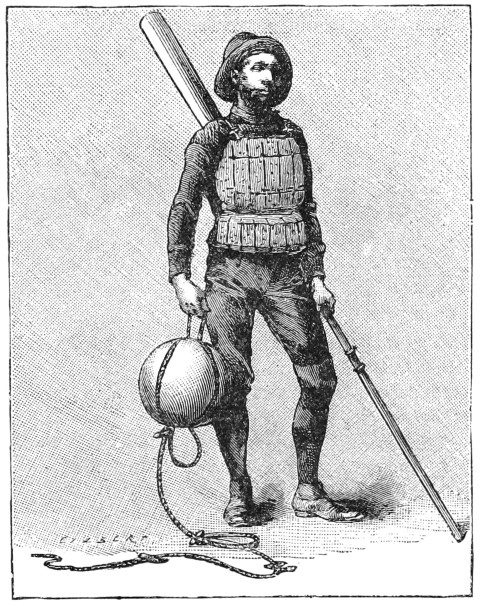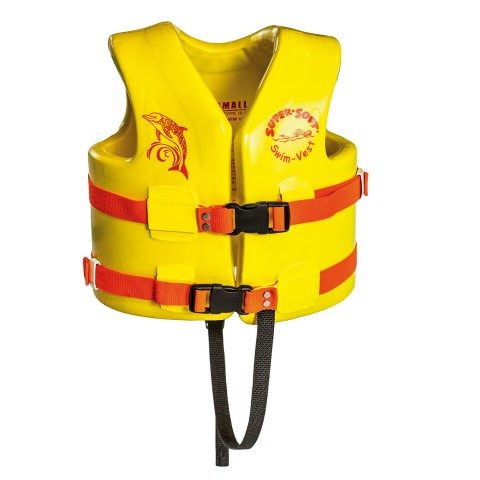

Landlubbers may not even realise that someone’s unassuming belt pack or collar is, in fact, a modern life-jacket. After all, when most non-boaties hear the phrase “life-jacket” they automatically picture those thick, hot, and inevitably musty keyhole devices of their childhood. Think Marty McFly in Back To The Future, dropping in on 1950s America with his poofy red down-filled vest. “Hey kid, what’s with the life-jacket?” Looking at modern PFDs, it’s remarkable to see just how far they’ve evolved.
NAVAL ROOTS
The first recorded instance of sailors wearing garments designed to keep them afloat goes back to 1805, when jerseys with wooden blocks sewn onto them were issued to British seamen at the Battle of Trafalgar. Imagine someone wearing a suit made of wooden shingles and you get the basic idea. Although there are no written records to support the contention that Admiral Horatio Nelson specifically intended the garments to protect his men against drowning, the epic naval engagement marks the first documented use of purpose-made garments with flotation qualities.

Nearly 50 years later, one Captain Ward with Britain’s Royal National Lifeboat Institution began issuing lifeboat crews with special vests constructed with rows of corks lining the exterior surface. Designed to be worn while conducting rescues at sea, these cork vests became widely used through the late 19th and early centuries, particularly by lifesaving organisations in Britain, Norway and Sweden. By the 1920s, the neat rows of exterior corks had been replaced by pockets sewn into the garment, each stuffed with a cotton-like plant fibre known as kapok.
While kapok life vests offered a number of advantages over cork – substantially greater durability above all – the new material was far from perfect. In use, kapok life vests were heavy, hot, and even bulkier than the old cork vests they replaced. As a natural fibre, kapok would degrade with time, especially when kept in damp environments. Worse still, the canvas outer shell could be rough on the skin, and their use normally resulted in painful chafing. Nevertheless, the design remained popular with boat owners worldwide right through the 1960s.
COME UP AND SEE ME SOMETIME
With the rise of naval aviation in the 1930s, navies, marines and army air corps worldwide faced a growing need for a far more compact life preserver that could be worn by pilots within the snug confines of airplane cockpits.
The answer lay in an inflatable life vest, patented in 1928 by a bright young American named Peter Markus. His simple design used a large, inflatable air bladder that lay flat across the chest until deployed, while simple straps under the arms and across the back provided nearly unrestricted freedom of movement – essential for pilots and aerial gunners alike.
Once activated, the self-inflating air bladder would hold the wearer face-up in the water. Officially patented as the Inflatable Life Preserver, the device became known among flight crews as a ‘Mae West’ because once inflated, it gave the wearer a similar profile to the busty 1930s Hollywood actress of the same name. Downed aircrew who owed their lives to the device became automatic members of the ‘goldfish club.’
SPACE AGE FASHION
It was perhaps a familiarity with the Mae West in newsreels that led to the widespread acceptance of consumer life preservers once servicemen returned home from the war, and the economy shifted back to peacetime pursuits. But because inflatable life vests like the Mae West were still considered high-tech military gear, traditional keyhole-style lifejackets made with kapok in a cotton or canvas outer shell remained the standard PFD on the consumer market.

It was only in the 1960s that these finally began to give way to nylon life vests with synthetic foam flotation. Lighter in weight, less expensive to buy, more buoyant in the water and vastly more comfortable to wear than outdated kapok styles, nylon PFDs beat the old stuff in every imaginable way.
Closed-cell foam also found its way into personal flotation devices around the same time. With its ability to be formed into snug-fitting vests or even trim waist rings (widely adopted by water-skiers) closed-cell foam PFDs offered a fresh and more contemporary styling that made them immensely popular among 1970s boaties. With their glossy exterior finish, rainbow of color options and affordable pricing, closed-cell foam PFDs represented an attractive alternative to more traditional lifejacket products.
The 1970s also saw the first widespread adoption of flotation devices designed not only to keep the wearer afloat, but to also combat the effects of immersion into cold water.
Initially styled like a regular jacket with a collar and full sleeves, these “floater coats” quickly caught on with those who spent time boating over cold water.
Before long, the simple coat had evolved into full-body suits. Sold as ‘survival suits,’ these specialised PFDs were originally designed for industrial and commercials clients such as fishing crews or oil rig workers, but quickly caught the attention of serious big water boaters for their ability to ward off hypothermia.
THE RIGHT STUFF
While wearing a good PFD can save your life, equipping your device with a few added safety items can help rescuers find you, and shorten your time in the water.
D-rings on many PFDs allow you to attach a whistle on a short, coiled cord. A small, waterproof flashing LED light, such as the type used by runners and cyclists, can help search and rescue teams spot you at night.

Better yet, consider adding a compact personal locator beacon (PLB) such as those made by ACR, Ocean Signal or McMurdo, or a satellite messenger like the Spot. These compact, battery-powered devices transmit a signal with your precise GPS coordinates, allowing rescuers to easily locate you on even the darkest night.
PFDS FOR PETS
Considering the number of dogs and cats one sees on boats, it’s no surprise that many manufacturers offer a full range of PFDs for pets.
While it’s tempting to dismiss the very idea of pet PFDs – don’t dogs float? They invented the dog paddle, didn’t they? – the reality is that like humans, pets can also tire quickly in cold water, or suffer from medical complications that could prevent them from swimming to shore.

Most pet life jackets are designed with some sort of foam flotation that wraps around the animal’s torso and neck. Apart from providing upright flotation, they also help retain body heat in cold water. As with humans, the fit is critical – check to ensure that the device is capable of holding the animal’s head clear of the water.
It’s also a good idea to select a pet PFD that incorporates a grab handle – a sensible and useful feature that makes it a snap to hoist the animal back into the boat. Photo credit: Outward Hound.
MODERN PFDS
As personal flotation devices continue to evolve through the adoption of even lighter materials, it is possible to find them today in a wider range of styles than ever.
That is particularly true for inflatable PFDs – the modern descendant of the original military Mae West. Manufacturing efficiencies have driven the cost of inflatables down to the point they have come to represent a steadily growing segment of the global PFD market. Self-inflating models use triggering mechanisms such as a hydro-static activator linked to a built-in CO2 cartridge to automatically inflate the device upon immersion in water.

“Hydrostatic inflatables represent today’s highest standard for both comfort and safety,” says Jason Leggatt at Mustang Survival, one of the type’s original proponents. “Because they’re much more comfortable to wear than traditional foam-based lifejackets, people do actually wear them, rather than just park them in some storage compartment. No one ever plans to fall overboard, so having that inflatable on all the time means that when you really do need it, it’s there.”
While the pricing of inflatable PFDs has come down to the point they’re now even being sold by mass-market retailers, they’re still two to three times the cost of a traditional foam lifejacket. But what’s the value of your life?
LET IT SHOW, LET IT SHOW, LET IT SHOW
When using an inflatable PFD, be sure to always wear it over the top of your rain gear.
High-end rain gear can prove so effective at keeping water out that it can actually impede water from reaching the hydro-static activator if you do take an unscheduled swim. Worse yet, an inflated PFD under a snug-fitting rain jacket can leave you feeling squished.




